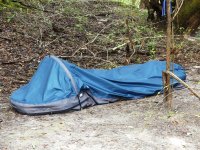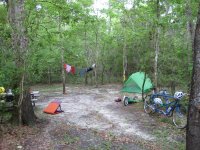- Joined
- Nov 30, 2017
- Messages
- 1,092
- Reaction score
- 1,495
Upper Suwannee Trip Report, Gear Evals, and How to Heal a Broken Ankle by Canoe.
May 13, 2019 - May 17, 2019
MONDAY
Feeling the river already in my bones, early Monday morning as I was braiding my hair in the hotel mirror. It came over me like an ocean swell; I only braid my hair when tripping. Executed final decisions on what to take, sealed up the packs and on to American Canoe Adventures in White Springs, Florida. A tiny town entirely lacking in big box stores or any place to purchase sun screen. I didn't forget sunscreen. It's just that the tube I brought, which looks just like the sunscreen tube, was actually just body lotion. It was about 8:45. The outfitter registered me with all the requisite contact information, but had no sign of stocked sunscreen. When asked, I was delighted to find they keep on hand the things people leave behind in boats and I had my choice of products. He suggested a top quality name and so I went off prepared. It turns out later to be important, but I did not know it at the time.
The shuttle ride took me and my 13 foot Mohawk canoe up to Griffis Fish Camp, as beautiful and quiet a campground you will ever see. There is a $2 launch fee which is stuffed in a box, payment on the honor system. Rain and thunderstorms were forecast for today, but when my boat and I launched into the Suwannee River, just before 10 am, the clouds were high and thick, cool (for Florida) and with a slight breeze. Perfect weather for canoeing in the south.
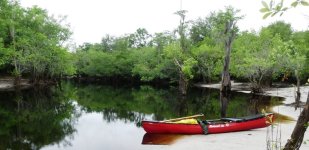
The 13 foot Mohawk is my new favorite boat. We are one headed downstream. I haven't felt so connected to a boat in a long time. Brad found the ad in Craig's List, along with a Mad River Guide. We paid $250 for the Mohawk and $200 for the Mad River, or maybe it was the other way around. I thought I would like the Mad River better, but found it a bit sluggish and I had to work a bit harder to keep it going straight on the Peace River. (Different trip report to come.)
The Mohawk came with a canvas bow cover, which I used as rain threatened. The cloud cover was thick and the river silent. The Upper Suwannee is a large tupelo swamp, with tupelo, cypress and mud in all directions. Few sounds penetrate until my ears adjust to the silence. Woodpeckers are drumming. A tufted titmouse calls. It takes all of 10 minutes before the first gator makes its appearance.
About an hour and a half after the put-in, on river left, is the only high land on this section of the Suwannee River. There is a posted sign, a picnic table, and this year, a tent. The tent did not appear to be occupied. If you are paddling in high water, this is your only opportunity to camp on dry land. Last year, I pulled out onto relatively solid mud and hung a hammock. There was no place dry enough or large enough to pitch a tent.
I passed the high point and kept paddling. Swallow-tailed kites plied the airways. Squirrels were common. Lots of yellow flies (deer flies.) Gators of all sizes were frequent. I rarely saw them before they saw me, but due to a trick of light and the time of day, around certain sand bars, if the gator was lying with its head downstream, I could sneak up on him. The gator would startle, whip around and plow into the water, raising a wake as as he seeks safety in the water.
The entire sequence does not take more than 3 seconds. Gets the old heart rate up while the boat bobs up and down just over the gator.
It rained on and off all afternoon. One of those days when it drizzles for a bit and you think you don't need the rain jacket, then it comes down hard, tails off. You take off the rain jacket thinking that's it. Repeat as often as necessary to get through the afternoon.
It may be time to talk about my adventures getting in and out of the canoe. I broke my right ankle just before Christmas. My first thought was, what if this happened on a canoe trip? My second thought was "On a canoe trip you would not have done anything so stupid." Because in the wilderness I am much more aware of my surroundings, and more careful about where I step, especially when on top of slope, headed down on slippery surface, in this case the wooden front steps. Although wood has a great affinity for water, water does not wet the surface of dry wood readily, thereby creating a slippery film. I knew this, but did not recall this critical piece of information until my foot slipped out from under me.
After going through the requisite surgeries, splints, casts, cast changes, walking casts and physical therapy, I have use of my right lower limb again...sort of. Two things have complicated my recovery. 1) My leg was in some kind of restrictive structure for three months. 2) The nifty nerve block I was given has worked all too well. Six months later, I still have parts of my foot I can't feel, and other parts that feel things that aren't there. Even stranger, I don't remember how to use my leg for anything other than putting one foot in front of the other. I seem to have lost proprioception. Remembering a story from Oliver Sacks, in which a woman who lost all proprioception taught herself to move again by looking at herself in mirrors distributed all over her house, I have come to have to watch my leg as I consciously think of what I want it to do.
The result of these adventures is that my right leg has forgotten how to do a lot of things it used to do without conscious intervention on my part. Simply put, I could not remember how to get in and out of the canoe. On our first testing trip several weeks ago, I swamped the canoe at the loading dock on the Peace River. Brad had to help me in and out of the canoe. It was quite embarrassing.
Brad taught me the Canoeing for Dummies trick for getting into a canoe. Pull the canoe so it is just on the sand. Set your butt on the seat. Swing your legs around. Scoot and push the canoe off the sand. "For the good of the trip," I used that technique to get into the canoe this morning, but now I had to get out. On the Peace River, Brad had always given me a hands up. How hard can it be to get out of a canoe? So here I am, alone on the Suwannee, rain threatening again, and I can't get out of the boat. After trying every configuration I could think of, I finally crawled out on my hands and knees.
I set up camp on the sand on the inside curve of the river amid tupelo and pop ash. I put up the Gorilla tarp in case it started raining again. More swallow-tailed kites. A great white egret. And frogs calling all night long. I intended to use this trip to assess the usefulness and comfort of some gear. I had with me a solo tent (REI Chysalis), a bivy sack (Outdoor Research) and a hammock (Emo double.) Once out of its stuff sack, it was clear the tent had seen its last trip and so it was sacked, so to speak. There was just enough high ground to fit the bivy sack.
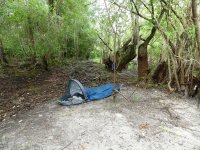
The bivy sack is just big enough for a thick pad and a sleeping bag, and a bit scary if you are prone to claustrophobia. I think it looks like those sleeping bags for kids that look like an alligator with its mouth open. (Brad, a vet, thinks it looks like a body bag and really doesn't like it.) Amazingly enough, once inside, it feels fine. There are two shock-corded poles that are supposed to keep the upper layer off your face. They work great in the living room and when setting up outside. Not so great when actually being used. Those nifty hoops gently ease downward until the top is lying on the head.
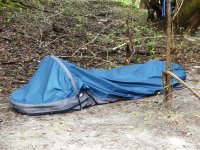
Shortly after I got situated in the bag and was delighting in breathing and looking at the sky through the bug net, it started raining hard. I pulled the top down and zipped it up tight, except for the 8 inch section you are supposed to leave open so you don't smother. At that point, it did feel a little close, but being very tired, I soon fell asleep.
TUESDAY
In the morning, I was still alive and dry - more so than any tent I've slept in during pouring rain. The poles that supposedly kept the hood up, were not only down, they were out of their sockets. Something was not right about this set-up but I did not know what it was. In spite of reading directions and looking at pictures of the set up, I could not see what I was doing incorrectly.
But the morning was clear with white puffy clouds, the kind of day that makes your heart sing. I walked upstream a bit to sit with my coffee and granola. Sitting quietly, a wolf appeared suddenly on the other shore. Not a wolf, but husky-looking, padding back and forth, watching me. S/he would "woof, woof" and look back. Alert, ears perked, s/he paced back and forth, back and forth. I wondered idly what I would do if the animal came across the river and attacked me. Seemed unlikely, but then I'd never seen an animal looking at me and observing me so closely. A predator, no less. Then she turned around disappeared over the sand hill.
More "woofing" and s/he appeared lower and downstream. A repeat performance and then s/he disappeared.
It was a perfect day for paddling.
![BWShS1C[1].jpg BWShS1C[1].jpg](https://www.canoetripping.net/data/attachments/11/11146-8035644f26a621ff0e72b5159e4515b5.jpg?hash=gDVkTyamIf)
Paddled under a bridge at Fargo disturbed by active construction. I distracted myself by looking upstream and also up under the bridge to see "the swallows nesting and soaring on wings of affection." (Ameen Rihani)
The destructive winds of Hurricane Irma (Fall 2017) still overwhelm the river in the upper stretches. Downed trees span the river in many places and depending on water level, one may have to jigger and jagger or lift over to get through them. Water level was low enough in one spot the way was blocked completely to canoe passage. Forced into a smaller channel, the current was more powerful and a bit trickier to navigate. I probably did too much in-canoe scouting, got myself trapped a time or two, but I really did not want to portage. I had packed for this trip with no portage in mind (ie, had a cooler for one thing) and my ankle was still a bit unsteady.
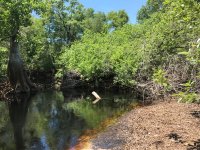
But there was nothing for it but to go around. As you probably know, anyplace that has narrowing of the river and full of logs also is probably too deep to walk. That meant paddling back upstream out of the pickup sticks to get to a sand bar on river right. Into steady current. Had to try this a couple times and think through the route and was finally successful. I now know that, as a former stern paddler now paddling solo, I only know how to use the front half of the boat, but more about that another time.
Clearly I was not the first person to carry around this blockage. While there was no path, there were certainly foot prints and bent herbaceous plants leading the way. It was an uneven carry, with more logs and obstacles to step over. I missed and bent the just healing broken ankle. It was rather painful and I sat down thinking, OK, this is it, you are out of it. But as I sat, the pain receded and strangely did not bother me again the rest of the trip. I did bind it in ace bandages, but still.
I finally got the canoe, packs, cooler over to the other side of the blockage. Decided to have lunch and sat for a bit. There was no easy entry to the current and the bank was almost straight down. I loaded the canoe and then gently pulled it straight down from the bowl. Immediately, the stern swung to the left and the entire boat started to turn over downhill. Bad idea. Twas angels kept the boat upright and managed to get it into the water upright and then even more amazing into it.
I have learned from these two days is that if one handicaps one's abilities, a trip can be as exciting as one in the far north wilderness.
May 13, 2019 - May 17, 2019
MONDAY
Feeling the river already in my bones, early Monday morning as I was braiding my hair in the hotel mirror. It came over me like an ocean swell; I only braid my hair when tripping. Executed final decisions on what to take, sealed up the packs and on to American Canoe Adventures in White Springs, Florida. A tiny town entirely lacking in big box stores or any place to purchase sun screen. I didn't forget sunscreen. It's just that the tube I brought, which looks just like the sunscreen tube, was actually just body lotion. It was about 8:45. The outfitter registered me with all the requisite contact information, but had no sign of stocked sunscreen. When asked, I was delighted to find they keep on hand the things people leave behind in boats and I had my choice of products. He suggested a top quality name and so I went off prepared. It turns out later to be important, but I did not know it at the time.
The shuttle ride took me and my 13 foot Mohawk canoe up to Griffis Fish Camp, as beautiful and quiet a campground you will ever see. There is a $2 launch fee which is stuffed in a box, payment on the honor system. Rain and thunderstorms were forecast for today, but when my boat and I launched into the Suwannee River, just before 10 am, the clouds were high and thick, cool (for Florida) and with a slight breeze. Perfect weather for canoeing in the south.

The 13 foot Mohawk is my new favorite boat. We are one headed downstream. I haven't felt so connected to a boat in a long time. Brad found the ad in Craig's List, along with a Mad River Guide. We paid $250 for the Mohawk and $200 for the Mad River, or maybe it was the other way around. I thought I would like the Mad River better, but found it a bit sluggish and I had to work a bit harder to keep it going straight on the Peace River. (Different trip report to come.)
The Mohawk came with a canvas bow cover, which I used as rain threatened. The cloud cover was thick and the river silent. The Upper Suwannee is a large tupelo swamp, with tupelo, cypress and mud in all directions. Few sounds penetrate until my ears adjust to the silence. Woodpeckers are drumming. A tufted titmouse calls. It takes all of 10 minutes before the first gator makes its appearance.
About an hour and a half after the put-in, on river left, is the only high land on this section of the Suwannee River. There is a posted sign, a picnic table, and this year, a tent. The tent did not appear to be occupied. If you are paddling in high water, this is your only opportunity to camp on dry land. Last year, I pulled out onto relatively solid mud and hung a hammock. There was no place dry enough or large enough to pitch a tent.
I passed the high point and kept paddling. Swallow-tailed kites plied the airways. Squirrels were common. Lots of yellow flies (deer flies.) Gators of all sizes were frequent. I rarely saw them before they saw me, but due to a trick of light and the time of day, around certain sand bars, if the gator was lying with its head downstream, I could sneak up on him. The gator would startle, whip around and plow into the water, raising a wake as as he seeks safety in the water.
The entire sequence does not take more than 3 seconds. Gets the old heart rate up while the boat bobs up and down just over the gator.
It rained on and off all afternoon. One of those days when it drizzles for a bit and you think you don't need the rain jacket, then it comes down hard, tails off. You take off the rain jacket thinking that's it. Repeat as often as necessary to get through the afternoon.
It may be time to talk about my adventures getting in and out of the canoe. I broke my right ankle just before Christmas. My first thought was, what if this happened on a canoe trip? My second thought was "On a canoe trip you would not have done anything so stupid." Because in the wilderness I am much more aware of my surroundings, and more careful about where I step, especially when on top of slope, headed down on slippery surface, in this case the wooden front steps. Although wood has a great affinity for water, water does not wet the surface of dry wood readily, thereby creating a slippery film. I knew this, but did not recall this critical piece of information until my foot slipped out from under me.
After going through the requisite surgeries, splints, casts, cast changes, walking casts and physical therapy, I have use of my right lower limb again...sort of. Two things have complicated my recovery. 1) My leg was in some kind of restrictive structure for three months. 2) The nifty nerve block I was given has worked all too well. Six months later, I still have parts of my foot I can't feel, and other parts that feel things that aren't there. Even stranger, I don't remember how to use my leg for anything other than putting one foot in front of the other. I seem to have lost proprioception. Remembering a story from Oliver Sacks, in which a woman who lost all proprioception taught herself to move again by looking at herself in mirrors distributed all over her house, I have come to have to watch my leg as I consciously think of what I want it to do.
The result of these adventures is that my right leg has forgotten how to do a lot of things it used to do without conscious intervention on my part. Simply put, I could not remember how to get in and out of the canoe. On our first testing trip several weeks ago, I swamped the canoe at the loading dock on the Peace River. Brad had to help me in and out of the canoe. It was quite embarrassing.
Brad taught me the Canoeing for Dummies trick for getting into a canoe. Pull the canoe so it is just on the sand. Set your butt on the seat. Swing your legs around. Scoot and push the canoe off the sand. "For the good of the trip," I used that technique to get into the canoe this morning, but now I had to get out. On the Peace River, Brad had always given me a hands up. How hard can it be to get out of a canoe? So here I am, alone on the Suwannee, rain threatening again, and I can't get out of the boat. After trying every configuration I could think of, I finally crawled out on my hands and knees.
I set up camp on the sand on the inside curve of the river amid tupelo and pop ash. I put up the Gorilla tarp in case it started raining again. More swallow-tailed kites. A great white egret. And frogs calling all night long. I intended to use this trip to assess the usefulness and comfort of some gear. I had with me a solo tent (REI Chysalis), a bivy sack (Outdoor Research) and a hammock (Emo double.) Once out of its stuff sack, it was clear the tent had seen its last trip and so it was sacked, so to speak. There was just enough high ground to fit the bivy sack.

The bivy sack is just big enough for a thick pad and a sleeping bag, and a bit scary if you are prone to claustrophobia. I think it looks like those sleeping bags for kids that look like an alligator with its mouth open. (Brad, a vet, thinks it looks like a body bag and really doesn't like it.) Amazingly enough, once inside, it feels fine. There are two shock-corded poles that are supposed to keep the upper layer off your face. They work great in the living room and when setting up outside. Not so great when actually being used. Those nifty hoops gently ease downward until the top is lying on the head.

Shortly after I got situated in the bag and was delighting in breathing and looking at the sky through the bug net, it started raining hard. I pulled the top down and zipped it up tight, except for the 8 inch section you are supposed to leave open so you don't smother. At that point, it did feel a little close, but being very tired, I soon fell asleep.
TUESDAY
In the morning, I was still alive and dry - more so than any tent I've slept in during pouring rain. The poles that supposedly kept the hood up, were not only down, they were out of their sockets. Something was not right about this set-up but I did not know what it was. In spite of reading directions and looking at pictures of the set up, I could not see what I was doing incorrectly.
But the morning was clear with white puffy clouds, the kind of day that makes your heart sing. I walked upstream a bit to sit with my coffee and granola. Sitting quietly, a wolf appeared suddenly on the other shore. Not a wolf, but husky-looking, padding back and forth, watching me. S/he would "woof, woof" and look back. Alert, ears perked, s/he paced back and forth, back and forth. I wondered idly what I would do if the animal came across the river and attacked me. Seemed unlikely, but then I'd never seen an animal looking at me and observing me so closely. A predator, no less. Then she turned around disappeared over the sand hill.
More "woofing" and s/he appeared lower and downstream. A repeat performance and then s/he disappeared.
It was a perfect day for paddling.
![BWShS1C[1].jpg BWShS1C[1].jpg](https://www.canoetripping.net/data/attachments/11/11146-8035644f26a621ff0e72b5159e4515b5.jpg?hash=gDVkTyamIf)
Paddled under a bridge at Fargo disturbed by active construction. I distracted myself by looking upstream and also up under the bridge to see "the swallows nesting and soaring on wings of affection." (Ameen Rihani)
The destructive winds of Hurricane Irma (Fall 2017) still overwhelm the river in the upper stretches. Downed trees span the river in many places and depending on water level, one may have to jigger and jagger or lift over to get through them. Water level was low enough in one spot the way was blocked completely to canoe passage. Forced into a smaller channel, the current was more powerful and a bit trickier to navigate. I probably did too much in-canoe scouting, got myself trapped a time or two, but I really did not want to portage. I had packed for this trip with no portage in mind (ie, had a cooler for one thing) and my ankle was still a bit unsteady.

But there was nothing for it but to go around. As you probably know, anyplace that has narrowing of the river and full of logs also is probably too deep to walk. That meant paddling back upstream out of the pickup sticks to get to a sand bar on river right. Into steady current. Had to try this a couple times and think through the route and was finally successful. I now know that, as a former stern paddler now paddling solo, I only know how to use the front half of the boat, but more about that another time.
Clearly I was not the first person to carry around this blockage. While there was no path, there were certainly foot prints and bent herbaceous plants leading the way. It was an uneven carry, with more logs and obstacles to step over. I missed and bent the just healing broken ankle. It was rather painful and I sat down thinking, OK, this is it, you are out of it. But as I sat, the pain receded and strangely did not bother me again the rest of the trip. I did bind it in ace bandages, but still.
I finally got the canoe, packs, cooler over to the other side of the blockage. Decided to have lunch and sat for a bit. There was no easy entry to the current and the bank was almost straight down. I loaded the canoe and then gently pulled it straight down from the bowl. Immediately, the stern swung to the left and the entire boat started to turn over downhill. Bad idea. Twas angels kept the boat upright and managed to get it into the water upright and then even more amazing into it.
I have learned from these two days is that if one handicaps one's abilities, a trip can be as exciting as one in the far north wilderness.

